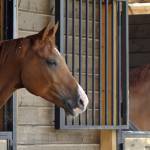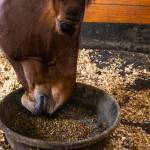Heaves and Other Breathing Problems in Horses

A common small airway disease in horses is known as heaves. Horses suffering from this malady show obvious signs while at rest. These may include a chronic cough, flared nostrils, and forced abdominal breathing. This characteristic type of breathing occurs as the horse contracts its abdominal muscles to force air through obstructed airways.
The obstruction is caused by inflammation, increased mucus production, and bronchospasm. Heaves arises from what is believed to be a full-blown allergic response, usually to dust from the horse’s feed and bedding. It is somewhat comparable to a person with severe asthma. A horse with this condition would not be capable of moderate exercise without becoming severely distressed. Heaves can manifest in many degrees of severity.
A less serious airway disease is known as lower respiratory tract inflammation (LRTI) or small airway disease (SAD). While this is not a full-blown allergy as in the case of heaves, it is an inflammatory process. It usually becomes apparent when the horse is asked for extreme exertion. This inflammation may not be noticeable in horses used for low-intensity pleasure riding, although the disease can become more severe with time until even light exercise is distressing.
Minor degrees of airway inflammation and small increases in mucus production quickly take their toll on the equine athlete attempting to take 150 to 200 breaths per minute, as is the case with horses in competition. Another complicating factor is that horses do not have a sensitive cough reflex. There can be quite a lot of mucus in the horse’s airways without triggering a coughing response. This is in sharp contrast to humans and dogs. An endoscopic examination of the airways can reveal large amounts of mucus in a horse with no history of coughing. A horse with respiratory disease does not necessarily cough.
If a sample of mucus is collected from the lungs, large numbers of neutrophils (pus cells) are usually found. Significant bacterial infections may be identified when the samples are taken to the microbiology laboratory. These bacteria can be the primary cause of the problem, or they can be a secondary, complicating issue following a viral infection. Secondary infections can increase the horse’s recovery time.
Common causes of small airway disease include infectious agents such as bacteria and viruses; noxious gases such as ammonia; and airborne particles such as mold spores and dust. Mold spores are the most common irritant constituents in stable air. When inhaled in large enough numbers, these spores can cause inflammation and irritation of the small airways, even in horses without an allergic condition.
The above causes can interact in many ways. For example, dust can increase a horse’s susceptibility to infection. Equally, a horse suffering a respiratory tract infection in a dusty environment will take a lot longer to recover than if it was breathing fresher air.
Nuclear medicine studies have shown that it takes at least a month for the cilia lining the airways to recover their function following a bout of influenza. In other words, while the horse may look sick for only a few days, its lungs will take up to a month to recover. At this time, the lungs will also be very sensitive to the inhalation of airborne pollutants.








